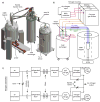Instrumentation for cryogenic magic angle spinning dynamic nuclear polarization using 90L of liquid nitrogen per day
- PMID: 28888182
- PMCID: PMC6411293
- DOI: 10.1016/j.jmr.2017.08.014
Instrumentation for cryogenic magic angle spinning dynamic nuclear polarization using 90L of liquid nitrogen per day
Abstract
Cryogenic sample temperatures can enhance NMR sensitivity by extending spin relaxation times to improve dynamic nuclear polarization (DNP) and by increasing Boltzmann spin polarization. We have developed an efficient heat exchanger with a liquid nitrogen consumption rate of only 90L per day to perform magic-angle spinning (MAS) DNP experiments below 85K. In this heat exchanger implementation, cold exhaust gas from the NMR probe is returned to the outer portion of a counterflow coil within an intermediate cooling stage to improve cooling efficiency of the spinning and variable temperature gases. The heat exchange within the counterflow coil is calculated with computational fluid dynamics to optimize the heat transfer. Experimental results using the novel counterflow heat exchanger demonstrate MAS DNP signal enhancements of 328±3 at 81±2K, and 276±4 at 105±2K.
Keywords: Cryogenic MAS; Dynamic nuclear polarization; Electron decoupling; Heat exchanger; Magic-angle spinning; Pulsed DNP; Solid-state NMR.
Copyright © 2017 Elsevier Inc. All rights reserved.
Figures







References
-
- Andreas LB, Jaudzems K, Stanek J, Lalli D, Bertarello A, Le Marchand T, Cala-De Paepe D, Kotelovica S, Akopjana I, Knott B, Wegner S, Engelke F, Lesage A, Emsley L, Tars K, Herrmann T, Pintacuda G. Structure of fully protonated proteins by proton-detected magic-angle spinning NMR. Proc Natl Acad Sci U S A. 2016;113:9187–9192. doi: 10.1073/pnas.1602248113. - DOI - PMC - PubMed
Publication types
MeSH terms
Substances
Grants and funding
LinkOut - more resources
Full Text Sources
Other Literature Sources

